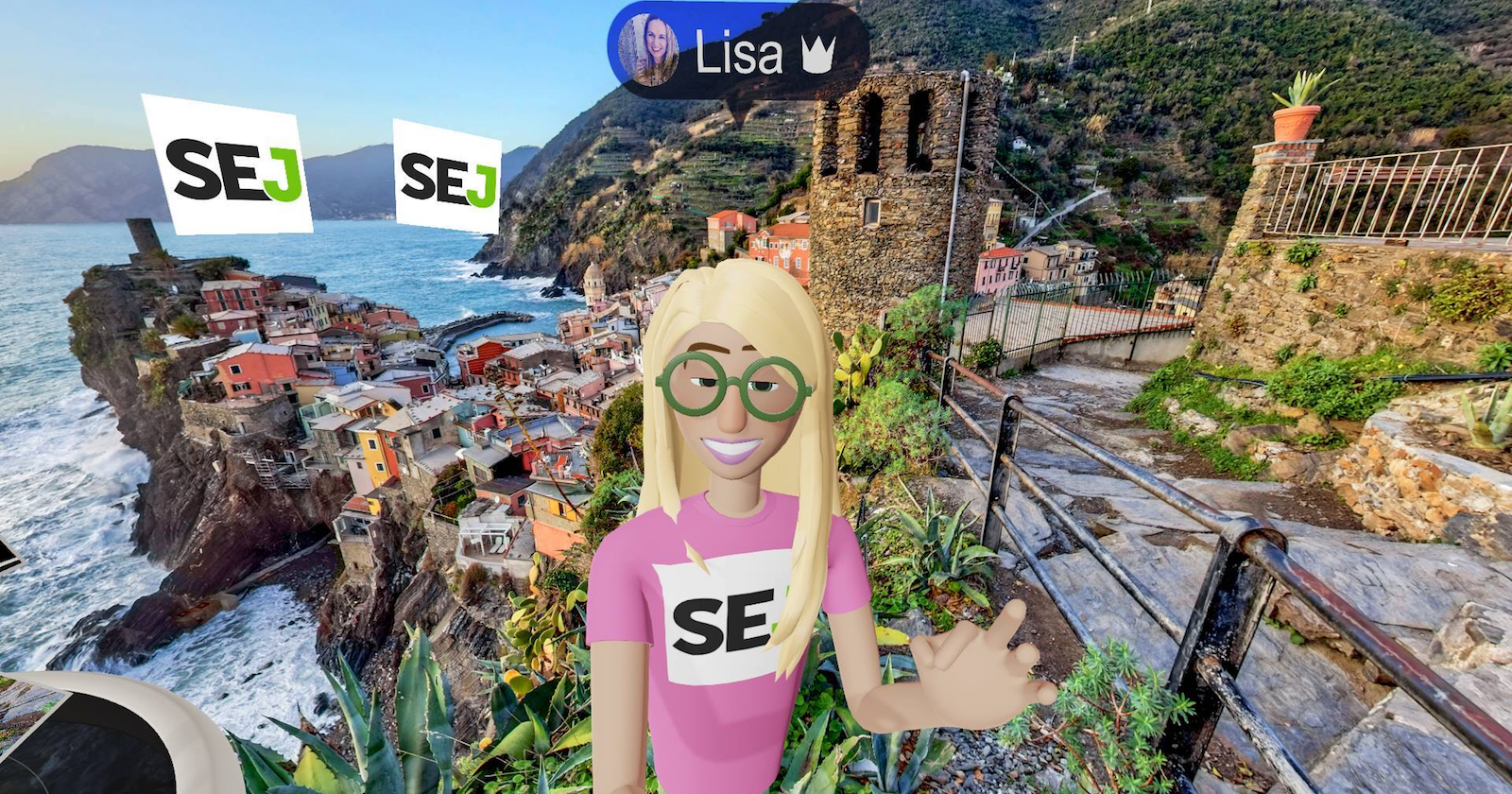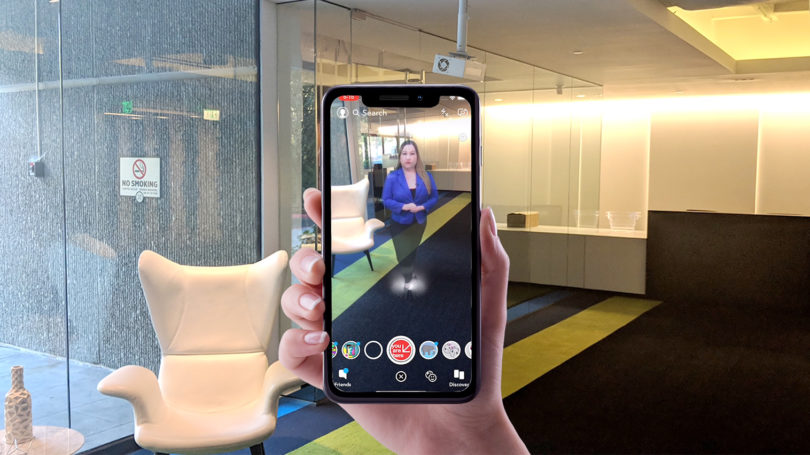The creative content marketing secret may be in the palm of your hand, or an extension of it.
The smartphone has evolved from a personal necessity to a revolutionary content-producing machine. Its built-in camera is wired with superpower-like features, formats, apps, platforms, lenses, filters, and social media channel magic.
Its output potential is making marketers think and rethink visual content strategies at record speed.
So what does the future of content marketing hold and how can you dare to be different?
Here are nine ways to stand out and explore new marketing realities with visuals.
1. Facebook Live: From Thumbs up to Thumbs Down
Last year’s content marketing golden child was Facebook Live and on its heels came the episodic-style Facebook Watch.
Yet just last month Social Media Examiner’s Michael Stelzner dropped a news bomb announcing to abruptly cancel three of its four weekly Facebook shows.
Ouch.
Right when brands were finally warming up to the concept of going live and Facebook dependency is at an all-time high, industry leaders are pulling the plug.
Is this the end of Facebook marketing as we know it?
Here Today, Gone Tomorrow
Dramatic pause.
Stelzner, who is the producer of the world’s largest social media conference, made it clear – just because the brand’s Facebook videos were pulled off the air, video marketing is stronger than ever.
The problem?
Long-form content was not working for the media company.
“This is a very rapidly changing world and when the facts change we need to change,” Stelzner said in his PSA. The video announcement broadcasted ironically via Facebook.
The message? Let’s not jump ship on Facebook.
Instead, be fluid, be flexible, and keep a constant eye on the type of content your audience is resonating with and congregating to the most.
As marketers, we must be in a constant state of what’s next and adjust accordingly. In other words either sleep one hour less or meditate one hour more.
The social networks are wasting no time in abandoning what isn’t working and poaching inspiration from the competition.
Instagram Stories and Facebook Stories are a lookalike audience to Snapchat’s original Stories feature.
2. Vertical Video: Baby, I Was Born This Way
Videos are the cupid of making everything real and authentic.
Just a few years ago, vertical video was almost considered taboo.
Now the video status is vertical for the win.
Why?
Smartphone users hold their phones vertically about 94 percent of the time.
Let’s face it, turning our phones from side to side is kind of a pain.
Thanks to Snapchat, vertical video has adapted some solid ground of staying power.
Next came Instagram Stories, then Facebook Stories and now the latest mostly horizontal player to join the vertical movement is YouTube. Progress!
Bottom line: if you want to stand out in the feed – go vertical.
Social media marketing channels are rewarding vertical video and influencers would rather be naturally vertical than awkwardly horizontal.
Need more convincing?
Vertical video is capturing a higher completion rate and CPM compared to horizontal video.
3. 360-Degree Videos: You Had Me At Hello
Are you sharing immersive experiences, places, and stories with your audiences?
A 360-degree video transports you directly to the moment. It allows viewers to see the entire 360-degree experience as if they were there themselves.
If you are a brand trying to create a virtual experience where feeling, mood and moments matter most, 360-degree video is for you.
Not sure what you need or how this works?
Check out the video style and order a legit camera to start out such as the Insta360 Pro and jump in with your audience – or someone else will.
4. 360-Degree Photos: The Spin is In
Facebook is known for its in-app support for immersive experiences. An easy way to stand out with your Facebook Page or Facebook Group is to use a 360-degree photo as your brand’s cover image (or in the news feed).
Next time you are at an industry event like this and you want your audience to feel like they are there, snap and upload a 360-degree photo.
Not sure which camera to get? Check out this 360 Camera review.
“Create a 360 infographic to immerse your content in a whole new world example – it can be used for holidays and for your Facebook cover,” said Social VR expert Navah Berg.
Check out this 360 infographic created and shared on World Photography day:
5. 3D Photos: Reach Out & Touch Someone
That moment you want to take your audience to a new dimension, no problem.
Go 3D.
No, not like the glasses from your mom’s Godzilla movies.
If you want to add a little layer, texture or depth – it’s possible to add 3D to your storytelling in social media.
There is no doubt, as of right now, standing out in the newsfeed is critical. Be first to step out of the masses with 3D photos.
Here’s a quick tutorial on how your brand can create this futurist content now:
Social PR Secret
“Image search powered by AI and AR will be critical for the future of search, especially as more companies like Samsung and 6D.ai move forward with the #AR Cloud,” said Cathy Hackl, VR/AR/MR Marketing expert.
6. Augmented Reality: Your Audience Wears Your Brand
When Carolina Arguelles, Head of AR Monetization Product Strategy for Snap, spoke at the world’s first Mixed Reality Marketing Conference this month, she emphasized how we are now in an era called camera marketing.
We no longer communicate by talking on the phone or even sending text messages.
Brands are challenged and encouraged by the aging and dominating Millennial and Gen Z demographics to adapt or die to augmented reality marketing.
Snapchat ads will probably never be easier to get ROI. If your audience is Gen Z integrate a paid strategy.
“Snapchat advertising is not just for big brands, you can be successful using Snapchat ads for as little as $50 a day inadequate stand,” Arguelles said.
7. Snap Camera: All Devices, All Aboard
Drop the phone.
Snapchat reality is now available for desktop and laptop – just pick your device.
What does this mean for marketing and brands?
“This means wearing Lenses while recording your next YouTube video, or even while streaming with apps like Skype, Google Hangouts, and OBS. We’ve also developed a custom Snap Camera integration just for streaming on Twitch,” according to Snap’s official announcement.
8. Holograms: Beam Me Up
If you thought the press release is dead, think again.
How about sending out your company news or product announcement as a holographic press release?
Hackl, with You Are Here Labs, unveiled the first-ever holographic press release at the PRSA International Conference this past October.
Now marketers can integrate 360-degree and 180-degree holograms into the marketing and public relations mix and share across AR/VR friendly social media platforms, such as Snapchat and Facebook.
“We’ll see more augmented reality and holograms on TV and used in social media,” said Hackl said.
9. Facebook Spaces: Your Avatar & Headset Are Waiting
It’s Facebook’s billion-dollar venture. Well, sort of.
Facebook’s CEO Mark Zuckerberg predicted at the launch of Facebook Spaces in 2017 he would connect 1 billion people in virtual reality.
Subscribe for Daily Search Insights
AI, PPC, and digital marketing news distilled to fuel success. Join the other 75k marketers!
Connecting social media and virtual reality coins the term Social VR.
Brands and marketers can get in early – just like the early adopters of social media for business.
It will never be easier than it is today to gain a competitive advantage in marketing by learning and immersing in what is accessible to you.
You will need to invest in a headset and PC in order to participate in Facebook Spaces as of this article writing.
If you are a Mac person, the word PC may not be in your vocabulary or mindset. It was difficult for me to wrap my brain around investing in a PC, although I did and it was worth the investment.
Facebook Spaces is more than a place to hang out and geek out in VR, it’s a powerful marketing tool for businesses.
What can brands do in Facebook Spaces today?
- Express your brand self.
- Create 3D content.
- Create visual content.
- Have a business meeting.
- Host a talk show.
- Go live in a Group.
- Create video content.
- Hold an event.
Get Ahead or Fall Behind
Brands and marketers looking to get ahead, or just not fall behind, must take a futuristic look at how content marketing is changing into new dimensions, mediums, and experiences.
How will it change your world?
More Resources:
- 3 Emerging Technologies in Marketing: What You Must Consider
- Augmented Reality Marketing: Moving From Gimmick to Strategy
- Everything You Need to Know About Virtual Reality Marketing
Image Credits
Featured Image: Taken by author, November 2018
In-Post Image: Cathy Hackl and You Are Here Labs



